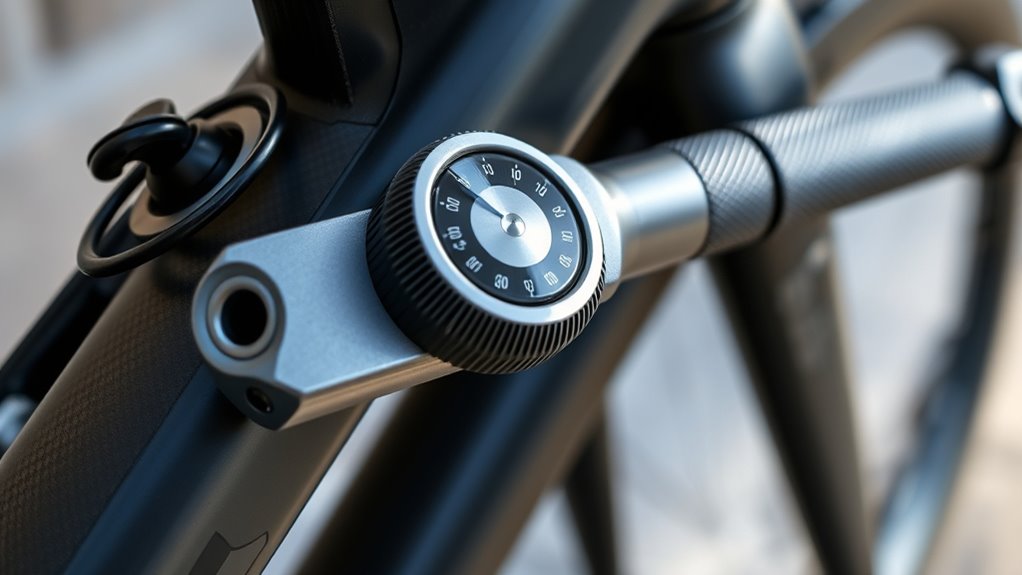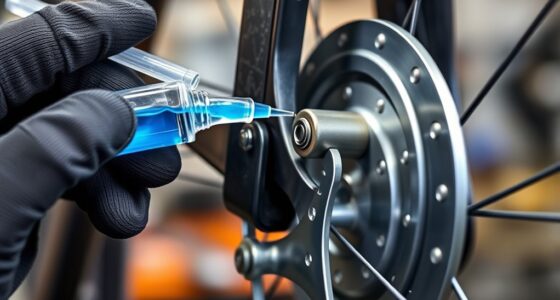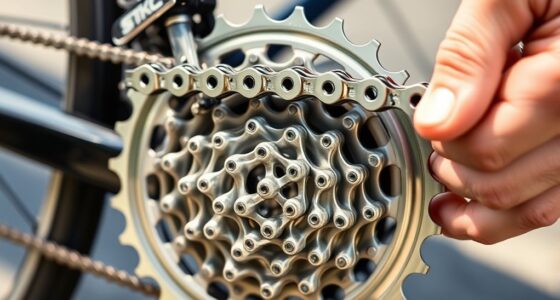When choosing a torque wrench for carbon frames, focus on units like Nm or ft-lb, and guarantee it’s properly calibrated for accuracy. Opt for a wrench with a range of 4-6 Nm to match common component specifications, and look for durable materials like stainless steel. Easy-to-use features, ergonomic handles, and compatibility with various fastener sizes matter too. To guarantee safe, precise tightening, you’ll want to explore these specs and more for excellent performance.
Key Takeaways
- Ensure the torque wrench measures in the appropriate units (Nm or in-lb) for carbon frame components.
- Select a torque wrench with a calibration feature to guarantee accurate, consistent settings.
- Opt for a click-type or digital wrench for precise, tactile feedback during tightening.
- Confirm the wrench’s torque range matches manufacturer specifications (commonly 4-6 Nm) for carbon frames.
- Choose a durable, corrosion-resistant wrench with ergonomic design for ease of use and longevity.
Understanding Torque Wrench Measurement Units

When choosing a torque wrench for your carbon bike frame, understanding measurement units is essential. Torque wrenches typically display measurements in either foot-pounds (ft-lb), Newton-meters (Nm), or inch-pounds (in-lb). Knowing these units helps you achieve proper measurement accuracy and avoid over-tightening or under-tightening components. Keep in mind that some wrenches require unit conversion, especially when switching between systems. For example, converting ft-lb to Nm involves multiplying by 1.3558, and understanding this ensures you apply the correct torque. Accurate measurements are critical for protecting your carbon frame’s integrity, so selecting a wrench with clear, precise markings and understanding how to interpret and convert units will ensure you maintain your bike properly. Additionally, familiarity with measurement conversion can be useful in ensuring torque accuracy across different systems and tools. Being aware of unit precision helps prevent measurement errors that could compromise your bike’s components or safety.
Key Torque Range for Carbon Frame Components

Knowing the right torque range is vital to avoid damaging your carbon components. You should aim for the manufacturer’s recommended torque values to guarantee a secure fit without risking over-tightening. Staying within these limits helps maintain your bike’s integrity and performance. Additionally, consulting with a professional mechanic can ensure proper application of torque settings specific to your bike. For optimal results, consider glycolic acid benefits for skin, which highlight the importance of appropriate treatment levels and regular application. Incorporating environmental considerations such as proper campsite management can also extend the lifespan of your equipment and protect the natural surroundings. Using a quality torque wrench ensures precise tightening and prevents over-tightening or under-tightening of your components.
Optimal Torque Values
Finding the right torque values for carbon frame components is essential to guarantee durability without risking damage. Typically, manufacturers specify a torque range, often between 4 to 6 Nm for critical parts. Using a torque wrench with proper calibration ensures you apply the correct force, preventing under-tightening or over-tightening. This is especially important for carbon fiber repair, where excessive torque can cause cracks or delamination. Always check the manufacturer’s recommended torque values before assembling or adjusting your bike. Regular torque wrench calibration helps maintain accuracy over time, ensuring each tightening is precise. Sticking to these ideal torque values protects your frame’s integrity, prolongs component life, and keeps your ride safe. Remember, proper torque application is key to maximizing your bike’s performance and longevity. Additionally, understanding torque specifications can help prevent costly repairs and ensure safe riding. Proper care and maintenance of your torque wrench also plays a crucial role in maintaining accurate torque readings. Incorporating professional guidance can further optimize your bike’s setup and longevity. Being aware of material properties can help you better understand how different components respond to torque and prevent damage.
Avoid Over-tightening
Applying too much torque on carbon frame components can cause serious damage, such as cracks or delamination, compromising the bike’s structural integrity. To protect your carbon frame’s durability, you need to stay within the recommended torque range. Here are three key points:
- Use a torque wrench with high accuracy to ensure precise tightening.
- Always double-check the specified torque values for each component.
- Avoid guesswork; over-tightening risks weakening or damaging delicate carbon parts.
- Remember that proper bed-in procedures can also help maintain the longevity of your carbon frame and components, and selecting the right tools can further prevent damage. Additionally, understanding the types of cookies used on related sites can help you manage your privacy preferences while researching tools and techniques.
- Consulting manufacturer specifications is essential to ensure you use the correct torque settings for each component.
Types of Torque Wrenches Suitable for Carbon Frames

When working with carbon frames, choosing the right type of torque wrench is essential to prevent damage and guarantee proper assembly. A click-type torque wrench is ideal because it provides an audible and tactile alert when you reach the correct torque, helping maintain consistent chain lubrication and frame alignment. Digital torque wrenches offer precise readings and easy adjustments, making them perfect for detailed work on sensitive carbon components. For quick jobs, a beam torque wrench is simple and reliable, but requires more attention to ensure accuracy. Avoid using adjustable or ratcheting wrenches that lack calibration features, as they risk over-tightening. Whichever you choose, ensure it’s compatible with the torque specs specified for your carbon frame to protect its integrity. Additionally, considering the wave and wind conditions during riding can help determine appropriate torque settings for components exposed to environmental stressors. Proper calibration and understanding of torque specifications are vital for maintaining the longevity of your carbon frame and ensuring safety during rides. Being aware of material-specific torque limits can further prevent accidental damage during assembly or maintenance.
Precision and Calibration in Torque Wrenches

Ensuring your torque wrench is precise and properly calibrated is essential for safeguarding your carbon frame. Accurate torque application prevents issues like metal fatigue and maintains your bike’s integrity. To achieve this, consider these key points:
Proper calibration of your torque wrench safeguards your carbon frame and ensures consistent, reliable performance.
- Regular calibration ensures your wrench provides accurate readings, avoiding under or over-tightening.
- Proper calibration helps prevent metal fatigue caused by uneven stress on components.
- Maintaining calibration records can support warranty considerations if you need to claim coverage after damage.
- Regularly reviewing calibration intervals based on usage frequency can further ensure consistent performance.
- Understanding data privacy can help you choose a fitting and meaningful name for your bike or gear accessories.
- Additionally, choosing a torque wrench with high-quality construction can enhance durability and measurement accuracy over time.
Using an uncalibrated wrench risks inconsistent torque, which can compromise your frame’s safety. It’s best to check calibration periodically, especially if the wrench is used frequently. This attention to detail extends your tool’s lifespan and preserves your warranty rights.
Material and Build Quality of Torque Wrenches

The durability and reliability of your torque wrench largely depend on the quality of its materials and construction. High material durability ensures your tool withstands repeated use without losing accuracy. Good build craftsmanship results in precise calibration and longevity. Look for wrenches made from stainless steel or hardened alloys, which resist wear and corrosion. Well-crafted components, like tight-fitting joints and sturdy handles, enhance performance and comfort. The table below highlights key aspects:
| Material Quality | Build Craftsmanship |
|---|---|
| Stainless steel or alloys | Precision-machined parts |
| Corrosion resistance | Tight, secure fittings |
| Wear resistance | Quality handle design |
| Long-lasting durability | Consistent calibration |
Choosing a wrench with solid material and craftsmanship guarantees dependable performance over time. Proper documentation and understanding of the material qualities can also help ensure your torque wrench maintains its accuracy and extends its service life. Additionally, selecting tools with excellent manufacturing standards can further improve their longevity and reliability.
Ease of Use and Ergonomics

A torque wrench that’s easy to handle makes your work quicker and more accurate. An ergonomic grip reduces fatigue and provides better control, especially during long sessions. When considering simplicity of adjustment, look for models with straightforward calibration features—so you spend less time setting and more time riding. To enhance usability, focus on these aspects:
- An ergonomic grip that fits comfortably in your hand, reducing strain.
- Clear, intuitive dials or digital displays for quick torque setting.
- Smooth, precise ease of adjustment to avoid overshooting your desired torque.
These features ensure you maintain accuracy without sacrificing comfort. Prioritizing ease of use and ergonomic design helps you work efficiently while protecting your carbon frame from improper tightening.
Compatibility With Different Fastener Sizes

Since bicycle components come in various fastener sizes, choosing a torque wrench that accommodates multiple fastener types is essential. Fastener compatibility guarantees you can accurately tighten different bolts without switching tools, saving time and reducing errors. When considering thread size considerations, look for a wrench with interchangeable heads or adjustable settings that match common sizes like M5, M6, or M8. Some torque wrenches are designed specifically for metric or imperial fasteners, so verify which standards they support. Proper compatibility prevents stripping threads or applying incorrect torque, both of which can damage your carbon frame. By selecting a wrench with flexible fastener compatibility, you ensure precise, safe assembly and maintenance across a variety of fastener sizes.
Additional Features to Consider When Choosing a Torque Wrench

When selecting a torque wrench for your carbon bike, considering additional features can make a big difference in usability and accuracy. First, look for lubrication considerations—some wrenches have self-lubricating parts or easy-to-access mechanisms, which help uphold precision over time. Second, check storage best practices; a case or protective cover prevents damage and keeps the wrench clean. Third, consider ease of calibration, ensuring you can verify and adjust torque settings easily, maintaining consistent performance. These features help extend the tool’s lifespan, improve reliability, and protect your investment. By paying attention to lubrication, storage, and calibration, you ensure your torque wrench remains accurate and ready whenever you need it.
Conclusion
Choosing the right torque wrench for your carbon frame is like wielding Excalibur—precision and care are your greatest allies. By understanding the specs that matter, you’ll guarantee your bike’s integrity remains intact, much like a master craftsman tending to a delicate masterpiece. Invest in quality, calibrate regularly, and select features that suit your needs. With the right tool in hand, you’ll keep your ride running smoothly—your own modern legend in the making.









